My Storm Chasing Biography
My Storm Chasing Biography
I just turned 41 years of age and am married - where have all thoses years gone! Has it been worthwhile? What have I achieved? How did I get into this madness we call storm chasing?
My name is Jimmy Deguara. I have a science degree with a major in Physics and Mathematics. I am also a trained mathematics and science teacher which is my primary form of employment. Storm chasing, or to be a storm chaser as you will find with most is not something that involves training. It is something that you develop on your own. Living on a farm, and with a scientific curiosity, I was able to quickly develop an understanding on how storms developed, categorise them into specific storm types and make general predictions without any training or even reading up on the matter. When I did begin reading on storm theory, I realised the concepts already established in my mind were storm categories that existed in reality. The internet through forum discussion in my case greatly enhanced my knowledge of severe thunderstorm behaviour and tornadogenesis.
What lead me to want to chase storms? 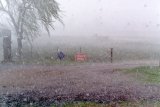
At a very young age, I had a fascination for the weather and severe storms with a particular focus on floods and heavy rainfall events sparking my curiosity. Gradually this fascination spread to other forms of severe weather - namely hailstorms and tornadoes. My interest was so intense that I breathed weather, talked weather constantly, and even drew pictures depicting natural disasters. Memorising dates of key events combined with my spacial skills provided a solid foundation in judging thunderstorm motion and storm forecasting.
You may call it storm chasing - my first desire was to be in an area where the worst conditions were experienced - primarily hailstones were my area of interest. I lived in an area which for some reason did not experience the most violent weather and I knew there were specific areas of 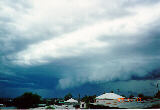
The successes and exposures since the movie Twister has had its impact in promoting storm chasing and more of an understanding by the public - at least I can say I am a storm chaser with pride and people appreciate what it is all about compared to when we first introduced storm chasing to the Australian public.
Did anyone influence my passion for storm chasing?
Although the passion was always there and I was determined to eventually venture out in the real world to discover atmospheric violence, there were some events that perhaps directed my move towards storm chasing. In 1989, I attended my first weather meeting in an interest group of an association called AMOS (Australian Meteorological and Oceanographic Society). Low and behold, the first meeting and there in front of me and with a mirror image of passion and interests was a professional and world renowned storm chaser called Chuck Doswell. His presentation was on "Storm Chasing on the High Plains" and his absolutely beautiful slides certainly was the turning point to realising the spectacular nature of tornadoes. I had no clue at this point the significance of Chuck’s status in the field of storm chasing and did not know such storm chasing even existed. It was the first time however that I was able to feel comfortable in my passion and interest!
It was not until the early 1990’s however that I began to investigate how I can begin a program of storm chasing - hopefully as a career. Nothing existed though to do this in
In 1993, I met my storm chaser and now website partner Michael Bath again at a storm spotter program meeting at the Bureau of Meteorology! We chased together and have compiled one of the largest websites about storm chasing in the world from an Australian perspective - Australian Severe Weather.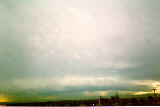
Michael and I chased locally in
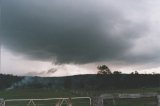 Later in 1998, another distant trip was attempted in the Northern Tablelands. Unfortunately, we faced a death ridge which produced fine weather. With little hope in sight, we ventured back to
Later in 1998, another distant trip was attempted in the Northern Tablelands. Unfortunately, we faced a death ridge which produced fine weather. With little hope in sight, we ventured back to
It was a matter of time however that through the information revolution via the internet things would change. About this time I had accessed a resource on the internet that produced experimental charts - my interest focused on the Surface Lifted Index and
Australian Storm Chasers tackle Tornado Alley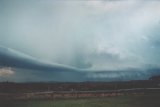
In 2001, another storm chaser and friend David Croan decided we should try tackle US chasing in search of tornadoes. The intentions were to at least get some nice structured storms - after all we had no experience of intercepting tornadoes. It was a nervous experience - all eyes were on us and expectations ran high. Well it was a surprise when the two aussies intercepted 6 tornadoes that year - including a giant violent tornado measuring up to half a mile wide that destroyed one house, threw two cars across the highway and snapped 7 power poles like match sticks! Realtively few American chasers were on this event. This was an incredible result given we were chasing storms out of our own territory, in the northern hemisphere where systems are reversed and also driving opposite to what we were accustomed. Consequently, we developed some respectabIity amongst US chasers. In years to come, I was able to intercept at least one tornado in every year I chased in Tornado Alley - the best year 2004 with 20 tornadoes that season - once again with David Croan!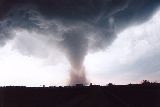
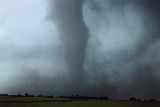
The experience and skills required for chasing storms in Tornado Alley were invaluable allowing me to chase far more successfully here in
What are some of the most memoriable chases?Having chased hundreds of storms since 1993, there are many stand out events so it is a difficult choice. What I tend to use as a guide are the events that gave me the most satisfaction and thrill - the so called adrenalin rush. The most recent stand out was a tornado that occurred in Australia which was closer in distance to me than any of the tornadoes I had intercepted in Tornado Alley.
This tornado occurring on October 26 2007 was associated with a storm I was 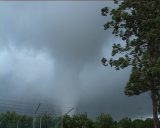 chasing for hailstones with Michael Bath. The second stage of the supercell with a new updraft was the one to prodice the tornado - I turned the corner and there it was. It had been shielded by the trees the whole time. From the first sighting I was within 300 metres of the tornado and managed to film most of its life cycle. The tornado also threw debris into a electricity substation managing to blow it up! This tornado also destroyed a local church and a few smaller buildings.
chasing for hailstones with Michael Bath. The second stage of the supercell with a new updraft was the one to prodice the tornado - I turned the corner and there it was. It had been shielded by the trees the whole time. From the first sighting I was within 300 metres of the tornado and managed to film most of its life cycle. The tornado also threw debris into a electricity substation managing to blow it up! This tornado also destroyed a local church and a few smaller buildings.
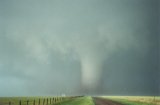 Another storm chase, in Tornado Alley will always be a significant event. The May 29 2001 White Deer tornado was a storm chase that seemed beyond the adrenalin rush - I had never seen such rotation in my whole life! This topped a day where we intercepted 5 tornadoes - a cyclic supercell! And of course I can never forget the incredible derecho we experienced two days earlier - the most incredible lightning I have ever witnessed.
Another storm chase, in Tornado Alley will always be a significant event. The May 29 2001 White Deer tornado was a storm chase that seemed beyond the adrenalin rush - I had never seen such rotation in my whole life! This topped a day where we intercepted 5 tornadoes - a cyclic supercell! And of course I can never forget the incredible derecho we experienced two days earlier - the most incredible lightning I have ever witnessed.
My achievements including the media
Most of what I have achieved have led to curiosity from the media. Most of the appearances in media and articles making use of resources collated on storm chases are summarised in the media section.
Namely, the most significant and more recent interviews on TV were Sixty MInutes Australia who came with us in Tornado Alley in 2004 and of course Angry Planet who I took around across NSW Australia in the search of severe storms. And of course, there was more than sufficient publicity with the Australian tornado intercept.
My ambitions for storm chasing in the futureI think I have fulfilled most of my dreams in storm chasing. I have seen tornadoes and experienced a couple of large and violent tornadoes. I have experienced a tornado from close range in
One more challenge is to be able to ensure that storm chasers who by nature are usually shy and single don’t feel discouraged in having family and balancing it out and being supported or at least understood by their spouses/partners. Storm chasing does not have to be seen as dangerous - well what’s the difference if a family rides a massive roller coaster! Are there differences in risks? Or is that perception?
My wife and family are very supportive of what I have achieved and always seems interested in what I am doing and seeing videos of what I have intercepted. Such support is invaluable in the life of a storm chaser. One challenge that proves difficult is to balance out invitations to parties and special events during the storm season. There is always that chance it falls on a monster storm day - what to do then!
Jimmy